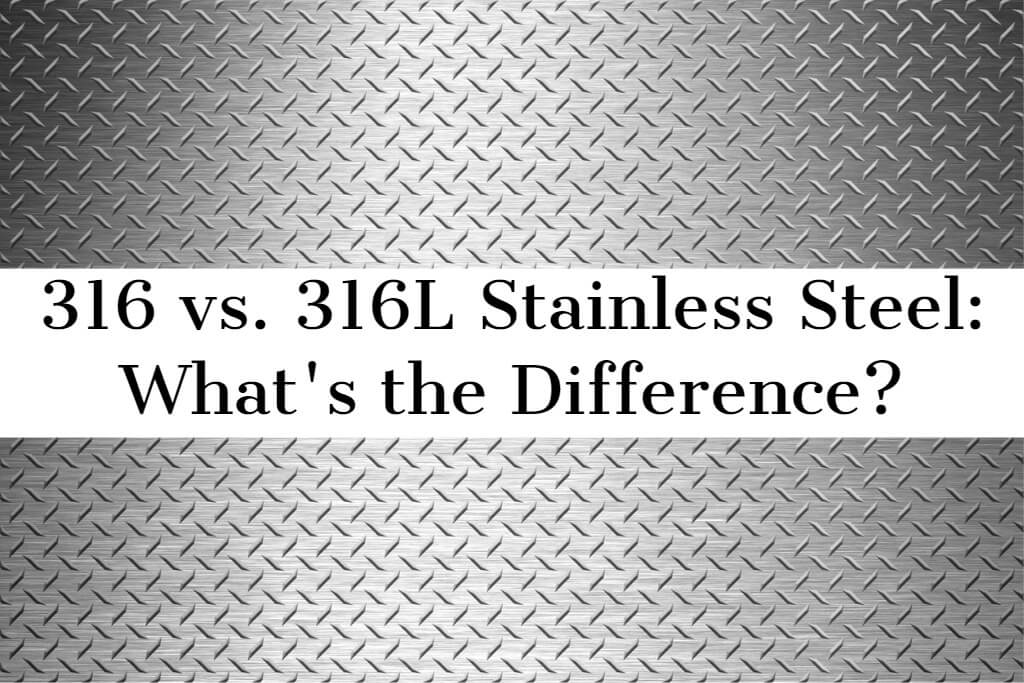Stainless steel is a crucial material in many industries due to its strength, durability, and resistance to corrosion. Among the numerous grades available, 316 and 316L stainless steels are two of the most commonly used, particularly in environments where corrosion resistance is a top priority. Although they share many similarities, there are key differences between the two that can significantly impact their performance in various applications. In this blog post, we’ll dive into the differences between 316 vs. 316L stainless steel, explore their unique properties, and help you determine which one suits your specific project needs best.
316 vs. 316L — The Basics
The primary difference between 316 and 316L stainless steel lies in their carbon content. 316L has a lower carbon content compared to 316, which offers distinct advantages in certain applications, particularly in terms of weldability and resistance to corrosion in certain environments. These differences also affect other characteristics, such as strength and cost, making it essential to choose the right grade for your project.
What is 316 stainless steel?
316 stainless steel is an austenitic stainless steel alloy that contains 16-18% chromium, 10-14% nickel, and 2-3% molybdenum, with a carbon content of up to 0.08%. The addition of molybdenum enhances its resistance to corrosion, particularly against chlorides and other industrial solvents. 316 stainless steel is widely used in industries such as chemical processing, marine, and pharmaceuticals, where exposure to harsh chemicals or saltwater is common.
Key Properties of 316 Stainless Steel:
- Corrosion Resistance: 316 stainless steel has excellent resistance to corrosion in a wide range of environments, especially in chloride-rich environments like seawater.
- Strength: 316 stainless steel has a high tensile and yield strength, making it suitable for applications that require robust materials.
- Temperature Resistance: This type of steel maintains strength and corrosion resistance even at high temperatures.
- Weldability: Good weldability, though it may require post-weld annealing to maximize corrosion resistance.
- Applications: Marine environments, chemical processing equipment, medical devices, and food processing machinery.
What is 316L stainless steel?
316L stainless steel is a low-carbon variant of 316 stainless steel, with a maximum carbon content of 0.03%. In comparing 316 vs. 316L, The lower carbon content makes 316L less prone to carbide precipitation during welding, which can lead to intergranular corrosion. This property makes 316L an ideal choice for welding-heavy applications or environments where it’s crucial to avoid potential corrosion after welding.
Key Properties of 316L Stainless Steel:
- Corrosion Resistance: Similar to 316, but with enhanced resistance to corrosion after welding due to reduced carbon content.
- Strength: Slightly lower tensile and yield strength when comparing 316 vs. 316L, but still robust enough for most applications.
- Temperature Resistance: Excellent performance at both high and low temperatures, similar to 316.
- Weldability: Superior to 316, as it doesn’t require post-weld annealing to maintain its corrosion resistance.
- Applications: Welded structures, pharmaceutical and chemical processing equipment, and components exposed to corrosive environments.
Comparison: 316 vs. 316L Stainless Steel
The primary differences between 316 vs. 316L stainless steel are cost, applications, corrosion resistance, strength, weldability, magnetism, and temperature resistance. Specifics include:
1. Cost
- 316: Typically more expensive due to its higher carbon content and strength.
- 316L: Slightly less expensive, especially in applications where welding is involved and post-weld annealing can be avoided.
2. Applications
- 316: Preferred in applications requiring higher strength and minimal welding.
- 316L: Ideal for welded components and structures where corrosion resistance is critical, especially in corrosive environments.
3. Corrosion Resistance
- 316: Excellent resistance to general corrosion but susceptible to intergranular corrosion if not properly treated after welding.
- 316L: Similar overall corrosion resistance when comparing 316 vs. 316L, but 316L has superior resistance to intergranular corrosion after welding due to its lower carbon content.
4. Strength
- 316: Offers higher tensile and yield strength, making it better suited for high-stress applications.
- 316L: Slightly lower strength compared to 316, but still sufficient for most applications, especially where corrosion resistance is a priority.
5. Weldability
- 316: Good weldability but may require post-weld annealing to prevent corrosion.
- 316L: Excellent weldability with no need for post-weld annealing, making it the better choice for welding-intensive projects.
6. Magnetism
- 316: Non-magnetic in its annealed condition but may become slightly magnetic when cold worked.
- 316L: Non-magnetic in most conditions, with even less tendency to become magnetic than 316.
7. Temperature Resistance
- 316: Performs well in high-temperature environments, maintaining its strength and corrosion resistance.
- 316L: Similar high-temperature performance to 316, with added benefits in welding applications.
316 vs. 316L — which one is right for you?
When examining the difference between 316 vs. 316L stainless steel, both are excellent choices for applications requiring superior corrosion resistance and durability. The choice between the two often comes down to specific project requirements, such as the need for welding, strength considerations, and cost constraints. 316 is the better choice for high-strength applications where welding is minimal, while 316L shines in welding-heavy environments where avoiding intergranular corrosion is paramount. Understanding the differences between 316 vs. 316L ensures that you select the most appropriate type of stainless steel for your needs, leading to better performance and longevity in your projects.
Visit Tampa Steel & Supply for Quality Metal and Metal Processing Services
Do you need help with metalworking and keeping your metal fresh? The experienced professionals at Tampa Steel & Supply are here to help. We provide the highest quality of services to our customers.
Request a Quote Online
Or Call Tampa Steel & Supply at (813) 241-2801

